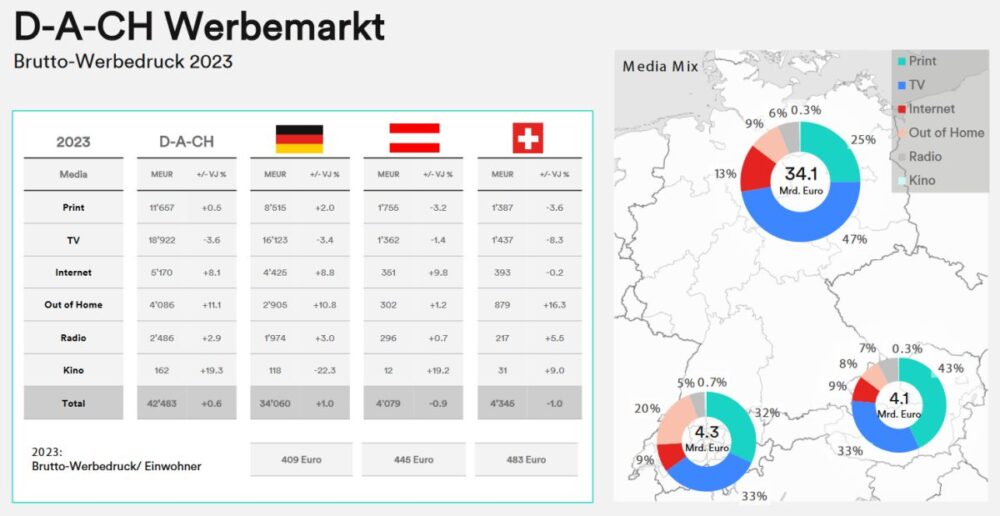Ad spending for moving image entertainment services stable despite pandemic
The "Business Intelligence - Video Entertainment" report by Zenith forecasts that advertising expenditure for video entertainment in ten key markets will fall by just 0.2% this year. This means that the industry will far outstrip the advertising market as a whole. The latter will shrink by a total of 8.7 percent in these same markets. The situation looks more precarious in Switzerland.

"In Switzerland, the picture is somewhat different," explains Maria Brinkmann, Managing Director of Zenith in Switzerland. "Despite the market entry of Disney+, we expect a decline of around 18% in this sector in 2020, which is even slightly below the general market trend. However, competition is also intact in this country, which is why this market will see a full recovery by 2022," explains Brinkmann.
The remarkable development of advertising expenditure in this sector worldwide despite the global pandemic and subsequent recession is the result of increased consumer demand, a growing number of providers and intense competition between these providers.
Increased consumption of moving image content
As people spent much more time at home than usual this year, they increasingly turned to video content for information and entertainment. In Switzerland, for example, significantly higher TV ratings were measured in all age groups during the lockdown in spring. At the same time, streaming services have invested huge sums in new content to attract new users. This is also forcing traditional TV channels to expand their offering.
The global advertising volume of streaming services has far outstripped advertising for traditional television channels. In the US, online video services increased their advertising budgets by 142% in 2019, while television brands only increased their spending by 15%. In the UK, advertising expenditure by streaming services rose by 79%, while advertising expenditure by traditional television increased by 34%. In both markets, broadcasters and pay-TV platforms temporarily increased their advertising investment in response to their new competition, but this strategy will not be sustainable as TV broadcasters' revenues decline. In the meantime, streaming platforms have increased their budgets even further as they try to take advantage of the current historically favorable opportunity to build a loyal customer base.
"Consumers today are faced with a vast and confusing array of moving images, with all providers vying for attention," explains Christian Lee, Global Managing Director at Zenith. "Video providers need to resolve this complexity and offer consumers the exact entertainment that matches their personal preferences with a minimum of effort for the user. Providers that offer compelling experiences and are more than just cloud storage for films and series will be the most likely to grow in the long term," continues Lee.
"In Switzerland, it will be exciting to see how many providers there will be room for in this small but attractive market," adds Maria Brinkmann. "The supply is huge and consumer purchasing power is high, but in the long term we expect a market shakeout, especially among streaming providers. Local providers in particular will tend to have a hard time."
Lockdown has made digital advertising channels even more important
In the past, moving image entertainment providers have spent more on digital advertising, out-of-home and cinema than the market average. However, empty cities and closed cinemas have forced the industry to rethink this media mix. This means even more digital advertising investments, which Zenith forecasts will increase from 53% in 2019 to 57% in 2020.
Advertising for moving image entertainment will continue to rise
While the industry is expected to significantly outperform the market in 2020, Zenith forecasts below-average performance for the next two years, with no growth in 2021 and growth of 1.3 percent in 2022. Streaming platforms will have fewer opportunities to increase their budgets after spending heavily in 2020, and traditional TV broadcasters will also have little room to maneuver due to declining revenues from TV advertising and pay-TV subscriptions.
Nevertheless, Zenith expects advertising expenditure for video entertainment to be 1.2% higher in 2022 than in 2019, while the global advertising industry as a whole will still be 0.6% below its 2019 peak.
Strongest growth in Spain and India
Advertising growth in the video entertainment industry hides considerable differences between the ten markets analyzed. For 2022, Zenith forecasts 27 percent growth for Spain between 2019 and 2022 and 19 percent growth for India. In the USA and Australia, on the other hand, Zenith expects advertising investments to fall by 5% and 7% respectively over the same period.
Both Spain and India are experiencing rapidly growing demand in the
video-on-demand sector, particularly on smartphones in India. Unlike in most Western countries, the Indian television advertising market is also enjoying rapid long-term growth and is expected to recover quickly in 2021.
In the USA, advertising revenues for video entertainment are expected to continue to decline after 2020, as rising online revenues will not be able to offset the ongoing decline in TV advertising and pay-TV subscriptions, which will reduce the available advertising budgets.
"Consumers are currently benefiting from a wide range of video providers vying for their loyalty," comments Jonathan Barnard, Head of Forecasting at Zenith. "This competition is providing a big boost to advertising investment in this sector this year. But this level of investment will be difficult to sustain in the long term, which is why we are forecasting very low growth for 2021 and 2022."
The Zenith study The markets covered are Australia, Canada, Germany, India, Italy, Russia, Spain, Switzerland, the UK and the USA, which together account for 57 percent of all global advertising investments.
Moving image entertainment refers to long-format video content that is offered either via conventional television or online, including free TV, pay TV and online video-on-demand platforms.








